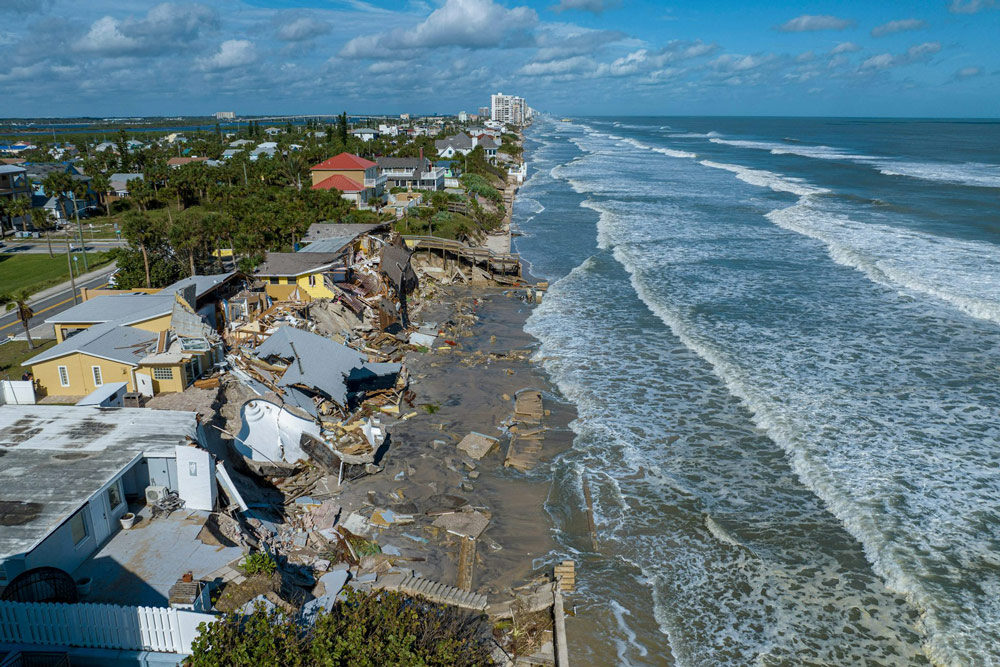Written by Chris Vagasky
Every hurricane season, massive groups of thunderstorms start to form into tropical storms around 600 miles off the west coast of Africa. Forecasters at the National Hurricane Center rely on weather satellites to look down on these storms and send back information on their location, structure, and intensity because Hurricane Hunter flights aren’t yet able to reach them.
Meteorologists use the satellite data to produce weather forecasts that protect ships and airplanes and get nations ready for a possible storm landfall.
Three of those satellites will soon no longer be available to meteorologists.
In a service change notice released on June 25, 2025, the Trump administration stated that the Navy’s Fleet Numerical Meteorology and Oceanography Center and the Defense Meteorological Satellite Program, or DMSP, would stop collecting, processing, and disseminating all DMSP data by June 30 at the latest. The chief of NASA’s Earth Science Division requested that the data cutoff be delayed until July 31.
As a meteorologist, I assist in training other meteorologists to track and predict tropical cyclones and research lightning in hurricanes. Here’s why meteorologists are worried about the DMSP data going dark and how they use it.
Looking inside the clouds
A weather satellite is essentially an in-orbit high-resolution digital camera that captures images of atmospheric clouds.
The majority of TV weather broadcasts use these satellite photos. Only during the day do they allow meteorologists to see the position and certain structural details of a hurricane.
Similar to a thermal imaging camera, meteorologists may use infrared satellite data at any time of day to identify the coldest cloud-top temperatures and pinpoint regions with the highest rates of rainfall and wind.
Despite being useful tools for hurricane forecasters, visible and infrared satellite imagery only gives a basic depiction of the storm. It’s similar to a doctor making a diagnosis after taking a patient’s temperature and performing a visual examination.
Meteorologists use the DMSP satellites to make more precise diagnoses.
Using special sensor microwave imager/sounder equipment, or SSMIS, the three satellites circle the planet fourteen times every day. In the same way that a hospital MRI examines into a human body, these allow meteorologists to see inside clouds. Meteorologists can use these tools to locate the storm’s core of low pressure and spot intensification indicators.
Accurately pinpointing a hurricane’s center enhances predictions of the storm’s future path. This enables meteorologists to create hurricane watches, warnings, and evacuations that are more precise.
Since 1990, hurricane track predictions have increased by as much as 75%. The ability of DMPS data to detect indicators of intensification is crucial because it is still challenging to foresee rapid intensification.
At some point, around 80% of large hurricanes with wind speeds of at least 111 mph (179 km/h) rapidly intensify, increasing the risks to people and property on land. Meteorologists are able to alert the public about these catastrophic hurricanes by determining when storms are about to intensify.
Where are the defense satellites going?
The Office of Satellite and Product Operations at NOAA explained that the data flow was cut off in order to reduce a serious cybersecurity risk.
Already, all three satellites have been in operation for longer than anticipated.
With a five-year lifespan in mind, the DMSP satellites were launched between 1999 and 2009. They’ve been in business for about 15 years now. The data would have probably gone black shortly because the US Space Force has determined that the DMSP satellites will be nearing the end of their lifespan between 2023 and 2026.
Are there replacements for the DMSP satellites?
The advanced technology microwave sounder is a microwave instrument found on three different satellites in orbit: Suomi NPP, NOAA-20, and NOAA-21.
Although it has a lower resolution, the advanced technology microwave sounder, or ATMS, can provide data comparable to the special sensor microwave imager/sounder, or SSMIS. For locating a storm or determining its strength, it offers a more blurry perspective that is less helpful than the SSMIS.
In late April 2025, the U.S. Space Force started utilizing data from ML-1A, a new defense meteorology satellite.
Some of the capabilities of the DMSP satellites will be replaced by the microwave satellite ML-1A. The government has not, however, stated if forecasters, including those at the National Hurricane Center, will have access to the ML-1A data.
Why are satellite replacements last minute?
Satellite programs are incredibly costly and are planned over many years, even decades. With ambitions to run until 2038, the current geostationary satellite program launched its first satellite in 2016. In 2019, the anticipated GOES-R successor’s development got underway.
Likewise, since the early 2000s, preparations have been in place to replace the DMSP satellites.
The National Polar-orbiting Operational Environmental Satellite System and Defense Weather Satellite System were canceled in 2010 and 2012 before any of their satellites could be launched due to financial shortages and delays in developing the satellite instrumentation.
The next-generation geostationary satellite program will receive more funds in the 2026 NOAA budget request, allowing it to be reorganized to reuse spare parts from current geostationary satellites. Contracts for improved lightning mapper equipment, ocean color, and atmospheric composition are also terminated by the budget.
A busy season remains
It is predicted that there will be six to ten storms during the 2025 Atlantic hurricane season, which spans from June 1 to November 30. As the DMSP satellite data is scheduled to be turned off, the season’s most active period lasts from mid-August to mid-October.
In order to monitor the tropics and make storm forecasts, hurricane forecasters will continue to employ every instrument at their disposal, including satellite, radar, weather balloons, and dropsonde data. However, the loss of satellite data, in addition to other reductions in budget, people, and data, may ultimately endanger more lives.
![]()
Chris Vagasky works at the University of Wisconsin-Madison as a meteorologist and manager of the research program.







